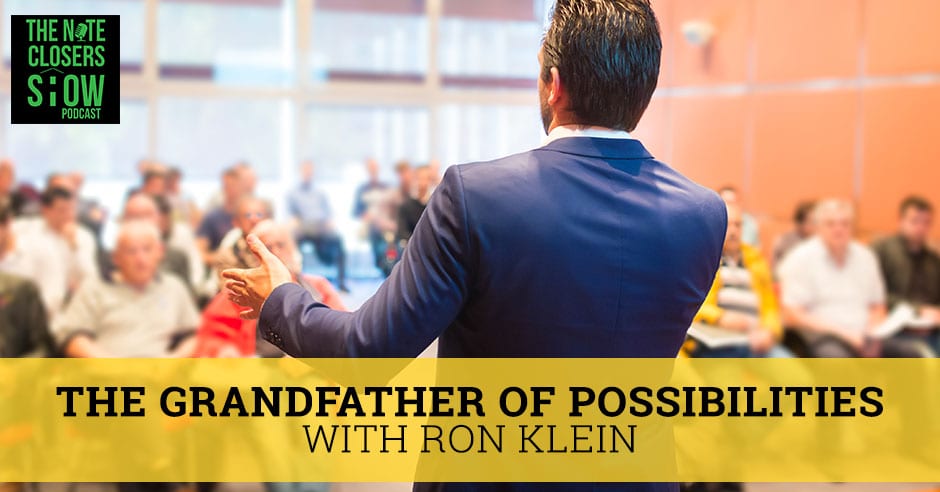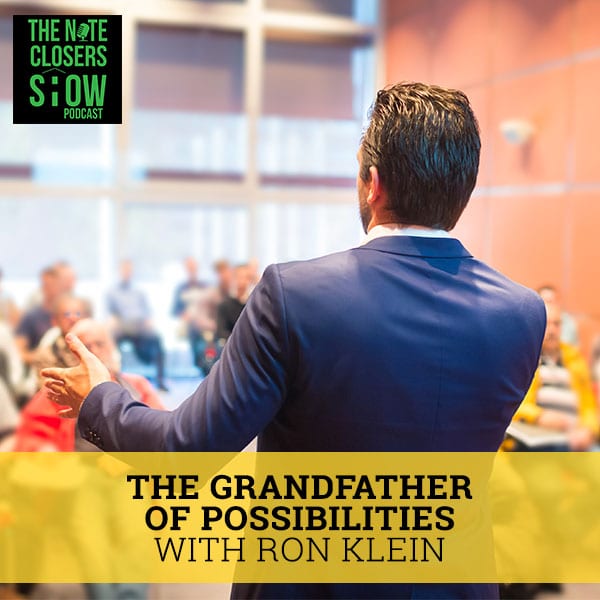
Ron Klein is not called The Grandfather of Possibilities for nothing. Ron classifies himself as a strategic adviser, a mentor, an innovator and inventor, a speaker, but mostly as a problem solver. Not many people may know it, but he’s been solving all sorts of problems. He invented the magnetic strip on the credit card that changed a few billion people. He developed the MLS system for real estate and the voice response for the banking industry where the key with your phone and get your account information back in voice. He had spent a lot of time on Wall Street and automated the New York Stock Exchange. He developed the bond quotation, the trading system, and the treasury system. Ron talks more about what he’s done and shares how he’s been able to fail retirement three times.
—
Listen to the podcast here
The Grandfather Of Possibilities with Ron Klein
I’m extremely excited and jacked up a little bit level above my normal crazy mode to have such a great guest. Steph and I are honored not only to call an acquaintance, but a friend. Somebody that I enjoy visiting with. When I run into them, he and his wife are two of the most amazing people on this planet Earth. We’re so lucky to call them friends. We’re honored to have the man, the myth, the legend, the grandfather of possibilities, our friend, Ron Klein, joining us. Ron, how is it going?
Thank you so much for having me.
Ron, you’ve done some amazing things. For those that don’t know who you are, go check out The Grandfather of Possibilities and you learn a bit more. Ron, why don’t you share a couple of the things that paved the way for where you’re at?
I changed a little bit of how people exist in this world. I classify myself as a strategic adviser, a mentor, an innovator and inventor, a speaker. I try and put them all in there, but mostly I’m a problem solver. In solving all these problems, I invented the magnetic strip on the credit card that changed a few billion people. I develop the MLS system for real estate, the voice response for the banking industry where the key with your phone and get your account information back in voice. I had spent a lot of time on Wall Street. I automated the New York Stock Exchange. I developed the bond quotation and trading system and the treasury system and did a little bit and I’m not empty yet. I failed retirement three times.
Let’s talk a little about some of the Wall Street stuff. It’s such an interesting story how you came and identified that as an opportunity. You find solutions to problems and solve some things relatively easy compared to what the problem is, what most people think. Wouldn’t you agree with that?
I agree. The way I do it is very simple because my whole mantra is simplicity. There is no such thing as a problem. A problem is the frustration. I turn it into a challenge and when I hear the word challenge I say, “There’s got to be a gift behind every challenge or an opportunity.” I simplify it and I say, “What is the given and what is the solution I’m looking for and everything else in between is the journey.” That’s the minutia. I don’t get caught up in that. If I want to go from point A to point B and that’s the purpose, that’s what I solve. It’s simplifying everything. The simplest challenge I ever had in my life was the credit card solution.
I was born in 1935, so I wasn’t privileged. My dad was a mail carrier. My mom worked in a department store. My most exciting thing were my toys, the old shirt cardboard that comes from the cleaners and a roll of masking tape so I can build anything. That was my education. For my birthday, I expanded. I would get a bowl of string and then it can be even more innovative. I was drafted into the service in the Korean War. I was fortunate because I had the GI bill and without the GI bill he couldn’t have gone to school. I went to school, I took electronic engineering and mathematics. I’ve got myself a couple of good jobs. I was known as a problem solver.
What happened was that a developer or a director of a very large department store came to me and said, “We have a problem and we’d like to see if you can solve it.” It takes too long to make a charge purchased. At that time, they didn’t call credit cards, credit card purchase. They called them a charged purchase. “What do you mean?” He said, “The merchant has to write it up and then we give them a big book every month of all the negative account numbers and he’s got to go through that and look up all those numbers. It takes so long and the burden’s on the wrong person, the burden is on the merchant.” I said, “Let me think about that a few minutes. What you want to do is take the burden off the merchant and speed up the process. That’s pretty simple.”
“What do you mean?” I said, “Let’s take all those numbers you put in the book of this negative account numbers and put that into memory system. This was back in the early ’60s. Memory systems was a big magnetic drill. Then we’ll give the merchant a little keypad and we’ll get up to the memory and when they come to make a purchase, they’ll key in the account number, that’s a little piece of plastic that has the person’s name on it. If it doesn’t show up on the merchant’s memory system then we’re good to go.” I said, “How simple is that?” I patented that as the first point of sale device. I said, “We have to make it a little bit easier put some smarts in that little piece of plastic.” Around that time, reel-to-reel tape recorders came out. You can record music or your voice on it and it would run it through at a constant speed. What would happen if I took a little piece of tape and paste it on the back of the plastic credit card, recorded the account number on it, and then build a little device that mimic the tape recorder and maybe the motor. Take that little card with a little piece of tape, slide it through this little device. That was the invention of the magnetic strip on the credit card.
If anybody was there with me back in 1964 when I started it, they would have come up with the same idea. If I wasn’t an engineer and I wasn’t technical, I would have had to hire somebody and say, “Build me this little thing that mimics a tape recorder and paste this.” I went to address, “Can you impregnate a magnetic material in the back of the card that looks like a piece of magnetic tape?” They said, “Sure.” That was it. The interesting thing Scott, is in this world of obsolescence. I filed for the patent in 1966 and it finally came through in 1969. In this world of obsolescence, how could a simple intervention like that last? Nobody can answer it.

Grandfather Of Possibilities: I’ll look around and represent other people’s products until I can decide what I want.
What’s funny is they keep trying to screw it up.
The reason it’s lasted all this time is because it doesn’t require energy. If it doesn’t require energy, it doesn’t radiate. If it doesn’t radiate, fraudulence was never at the point of sale is the man in the middle or at the server. That’s why it lasted. They came up with this whole ingenious idea of the chip and that’s a whole new story.
Every time I’m at PFS, “Do you have a chip card?” This takes longer than what it used to.
Here’s the problem, first of all, they say it’s better than anything else because it has an algorithm and it re-computes, print number and so on. That’s wonderful. The chip is a little computer and when you energize and put power on that little chip, it becomes a transmitter. While that chip is in your wallet, if it’s not in a special sleeve, I can come up behind you with a scanner, energize that chip. While you’re standing in line to use the chip card to make a purchase, you put it in the machine. What happens when you put it in the machine? First of all, it’s slow. It gets power from the machine and it energizes the chip. It’s a transmitter. Everybody around that within maybe 70 feet or so or closer, can have a little scanner in their pocket. Arlene’s debit card was compromised. Somebody must’ve scanned it and grabbed it. I’m not a fan of the chip.
The point was since the invention of the magnetic strip on the card, which is used in many different functions, it was a simple invention. From that, people started saying, “You’re a pretty easy problem solver. What else can we throw at you?” Frank Perdue came up to me and I helped him with the formula to grow chickens in eight weeks. All we were doing is fueling them with the food, different food that they loved that was more nutritious. They’ve gotten healthier and grew into maturity in eight weeks instead of long-term. Then Narab came to me, the board of realtors and they were saying, “We’ve got somebody here at point A and they want to move to point B. They’re in New York and they want they want to move to California. We want to be able to tell somebody in California that there’s a guy in New York coming and he needs a three-bedroom house with two beds and close to the school and swimming pool, etc. How do you do that?”
I came up with the idea of MLS and how you connect to the central computer, I built little suitcase turtles. That’s how I started it, and the acoustic coupler in it because at that time with no internet, the only way you could connect to a computer is to dial up their modem. It would do that funny screaming sound and then you could send the information. There were no touch tone phones around that time, this was 1967. It was mostly dial phones with the big receiver and I made an acoustic coupler that the phone would fit into this acoustic coupler. You dial up the computer, the computer would answer and then we would take buttons and switches that would set up all the parameters and beep that through the phone down the line.
That was the only reason they got the information in there. I formed a company and it continued to grow to 125 employees, because software wasn’t even invented then. You built everything with hardware, transistors and resistors and capacitors, printed circuit cards. I had a big manufacturing facility. We were building this for the banks, for voice response, and for the realtors. It became an interesting little company that I needed money because I couldn’t afford to pay the payroll. I hooked up with a couple of good investors and they funded me with $750,000. In the early ’60s, $750,000 then was like billions to me. We were able to grow and the company continued to grow.
I was running out of money again because I couldn’t afford to keep up with the material and the payroll. My investors came and said, “How about if we go public? I said, “What’s public?” I was a young guy then and I said, “Public, isn’t that the things that they put out at the sites when they build and they use these facilities to go public?” They said, “No, we’re talking about the stock exchange.” I put together a very successful public offering because I went to the library, got a book called the Securities Act, read it from cover to cover.
I became an expert on registration. Took the company public and raised another $1.5 million. The company looks so attractive that a major insurance company came to me and said, “We’re very interested in maybe acquiring you or buying your company.” I was starting to reach retirement age at that point, I was 34. I sold the company and I’m going to go fish. After three weeks, fishing becomes very boring and I said, “I’ve got to go back to work.” That was my first failure of retirement. I came back to those people and said, “I’ll surrender all my options stock, I’ll keep the money that you gave me, just turn me free.” They did.

Grandfather Of Possibilities; Don’t get caught up in the minutia. Simplifying everything will help you get from point A to point B.
I started another little company. I said, “What am I going to do? I don’t want 125 employees. I want something simple. I want to build myself a cash cow. How do you do that?” Meanwhile, I’ll look around and represent other people’s products until I can decide what I want. I was pretty good in communication so I started calling on some of my old clients. I was in with Associated Press and I was talking to a guy there. I was selling him some communication gear and I saw a bid sheet list, upside down. I was trained to read upside down as a salesman. I asked them what is this? He said, “We’re in the communication business. We use a lot of teletype machines.”
Teletypes worked before email. It was like a typewriter with a paper tape punch and a printer. They would type messages and would go over telephone lines and receive that somebody else’s tele thing. I said, that’s pretty interesting. He said, “Western Union provides these on a bid every week. They refurbish them. We don’t need them anymore. If you’d like, you’re welcome to the bid sheet.” That changed my life. I rented a truck and then Western Union was about sixteen miles from my home in New Jersey and they were in Pennsylvania.
I went there and I said, “Let me look at what you guys have.” They had all these teletypes and then right in the process of liquidating all their teletype machines because they’re going into the satellite business. They had 12,000 machines. They were ancient. I said, “People are still using these. I could take them and use them for parts and sell them $0.50 on the dollar the parts to big companies like ITT and RCA who uses teletypes and I bid pennies on the dollar and I wasn’t very careful. Nobody else bid on those machines. I found out that I never checked to see where they were. 4,000 were in a warehouse in Allentown, Pennsylvania. That was pretty close to my home. The rest of them were all over the country, Dallas, California, Texas. They were everywhere. They told me, “Ron, you have to take possession of these machines within 30 days because you own them.” They weighed hundreds of pounds each. These were big steel cabinets with keyboards, printers, paper tape punches and they were used on battleships. I figured, “I don’t own these machines, I own a liability. I have to get rid of them, what am I going to do?” My life changed.
I figured I’ll give them to the junk man. Junk man came he says, “Let’s take a look and see what’s in these machines. Let’s look in the bottom.” They had big cabinet areas. He opened it up, they were loaded with printed circuit cards, with the transistors and everything on it. They were made back in the early ’50s or late ’40s and they used gold traces to connect everything. Everything was gold. Gold has great conductivity and it wouldn’t rust when it was out at sea on the battleships. Gold was cheap then. It was $0.35 an ounce. I said, “What are we going to do?” He said, “If I take all these circuit cards, and submerge them into a cyanide bath, the cyanide will eat the gold off, it surfaces to the top. It becomes gold salt. We assay this, sell it, and we’re good.” I said, “Do it.”
He had 8,000 machines with all of these thousands of circuit cards and he said, “What we’ll do is we’ll cash it in and we’ll be in the chips.” He did it and I won. He did a good job on this and at the same time, gold went from $0.35 an ounce to $800 an ounce in that year. We were so fat in cash that it was incredible. I had a bigger liability because now I own 8,000 pieces of junk in steel cabinets, printers, keyboards, that had no value because they couldn’t work. I was running out of time. I call the junk dealer back, and I said “What can we do?” He said, “Let’s look at these things carefully.” I looked at them and tested them, they’re very rich in chromium in the steel. I happened to know that there’s a foreign car manufacturer, that introduce their car into the US and they’re having a little bit of a rush problem. They’re looking for anything that they can get that has chrome in it. I said, “Great.” We gave away all that material, all the chromium that was in the cabinets to this foreign company for nothing, and I was in business. I’ve got 4,000 teletypes in a warehouse in Allentown, totally paid for and now I was in the teletype business to refurbish and all because I read a bid sheet on the guy’s desk. That’s part of the story.
What I love about that is you didn’t let a problem stop you. You went and looked for a creative solution to making things happen. You reached out to professionals because I think a lot of people may see a problem and they don’t know where to turn or they don’t ask for help, so they stopped down. A confused mind is a no mind.
I’m going to give your readers the one solution then the secret to success and how it manifests itself. The answer to success in anything that’s business or a personal is three words. Let it be smart, daring and different. When I say smart, that doesn’t mean a PhD from Harvard or a big degree. It means pay attention, learn something new every day. Listen and learn. No matter what it is, even if you don’t think you’re interested in it, it may be prove to be very valuable to you and that’s important. Being smart is learning how to listen and learn something new every day.
The second thing is to be daring, daring means don’t be afraid to make mistakes. If you’re not making a mistake, you’re not learning anything. If you pick the wrong color the first time, paint it in a different color. There’s only plan A don’t be afraid to make a mistake. Learn from your mistakes, that’s how you grow. The last thing most important is to be different. Ideas don’t sell, benefits do, if you want to try and sell an idea, sell a benefit. Everything I’ve ever done to solve problems or meet a challenge, it’s been because I was smart, daring, and different. I wasn’t the sharpest knife in the drawer. I stopped and I said, “Wait a minute. What’s the given here? What’s the solution I’m looking for?” Don’t get caught up in the minutia in between. That’s how you solve the problems.
We see that a lot with our line of work here with buying distress that trying to figure out a solution sometimes it is often the simplest things. Pick up the phone. Talk to the borrowers or you buy a big bulk, you can’t take the whole thing down. Call somebody else who might be interested in jumping in on with you and make it a win-win.

Grandfather Of Possibilities: Concentrate on being smart, daring, and different. Have a mission, vision, and purpose.
Identify what it is that you that you have to work with and then ask yourself, “Where am I going? This is something for your audience to think about. We have a mission, we have a vision and we have a purpose.” The mission is what you do and then that mission, it’ll expand constantly. Being enhanced, lots of things will come about and that will have a big effect on your life. Your vision is the ultimate. You like to take it to the moon, you want it to be the biggest and the best. One thing that most people have problems with is very few people out there can answer it. “What is your purpose?” They think your purpose is directly tied to the mission. It is and it isn’t. It took me a long time to figure out what my purpose was. Purpose is never to be a burden, never be a burden to anyone else. Never give anyone the anxieties that they don’t deserve just because it’s me. That’s what you have to concentrate on. Smart, daring and different and have a mission, vision and purpose.
I was king in the teletype business because I had all these 4,000 machines. I could sell parts, I could refurbish some. I was doing fantastic. I hired a couple of technicians. I had a little shop. I was so happy. I had named my company, General Associates because I had no idea as to what I wanted it to be. After I got rid of all the junk machines and got the gold sold, I got a call from the New York Stock Exchange about three months later and they said, ” We understand this little company in New Jersey called General Associates, bought all the teletype machines from Western Union. In that package of teletype machines, there were 273 very special wall-mounted type machines that we use here at the Exchange as inquiry stations on the trading floor. This was in the mid ’70s. We’re expanding our trading floor and we don’t have enough inquiry stations and we don’t want to go back to AT&T and rent them. Are you interested in doing business?”
I said, “Absolutely. I’ll give you a full payout lease over two years so that you own them. Give them to your reasonable price if you give me a maintenance contract to maintain them on the trading floor for the life of the machines.” They said, “Absolutely. We don’t want to maintain them. You’re hired.” They paid the whole pay out lease. I was making good money there renting. I ran 200 machines and kept 73 spares. I figured I can’t afford to have anything changed, and I started a maintenance company. I hired a technician in New York. I drove every morning to the Wall Street, New York Stock Exchange to run around on the trading floor and make sure this thing operated smooth. I was in the cash cow business. I had maintenance contracts. I’m getting maintenance on every machine, every month. If something would go wrong during the day, we would just swap out with a good machine or spare. I would take it back to my shop in New Jersey, get it repaired, and take it back to the Exchange next day. What a fantastic three-man business.
I had a tech making the repairs, the tech on the floor, and myself. Walking around the trading floor, taking care of everything and the traders love me. The opportunity was fantastic because while I was there, I saw this institution that functioned on inertia because they had little pieces of paper and writing down using the vacuum lines, running upstairs, downstairs. At the end of the day, the paper was up to my waist. That’s how much paper was on a trading floor. Everybody would write, throw down, right throw down and I saw so many ways to automate the exchange and make it a lot easier for them. They thought I was IBM. I would come in and solve a problem. I would outsource it, hire a programmer to do something. We would fix it, it was done. They love me. What an opportunity.
In 1983, because I was constantly walking around on the trading floor, I went to the bond trading floor. I saw it quite a bit and it was an auction market. The New York Stock Exchange trades equity stocks, and they trade fixed income, which is the corporate listed bonds. That’s the fixed income. The stock market was automated a long time ago and the bond market, they never how to make it. It’s an auction market. Going in on the bond trading floor, these guys are throwing their hands up and down, bidding, and shaking, and screaming on the phone. I figured this is ridiculous. I went to the exchange and I said, “Why isn’t this automated?” They said, “Ron, they’ve been doing it like this for 205 years, they’re not going to change.” I said, “I can automate that so simply and fix it, that they could sit up at their desks on Wall Street and trade in automatically.” They said, “It’ll never work.”
I said, “If I build a little filter system and prove to you it can work, would you give me an exclusive license to be the vendor of choice to provide automated stock or automated fixed income bond trading on Wall Street?” They said, “Yes, because it will never happen.” I went to an attorney, I dressed up, a beautiful contract, gave it to them. We signed the contract and I built this little box. That simple little box that we put on the main trading line for the New York Stock Exchange. It would filter out all these bonds. We have a little video terminal keyboard and I could key in the bonds of choice. When those bonds would pop up, it would alert me.
I started calling every bond trader of Wall Street. After I demoed it in Wall Street at the bottom floor. If I wasn’t buying or selling a bond in five seconds, they’d hang up on me. I built this magnificent system, simplified it. “How am I going to sell it?” I befriended the leading bond trader on Wall Street who managed the biggest bond for Wall Street. I said, “Joe, I’m going to give you this thing free for 30 days. I’m going to run a leased telephone line in your office for 30 days. Use it, try it. It’s monitoring the bond trading on the bond trading floor and it’s faster than what they’re doing on the floor.”
He started using it. Two weeks later his phone rang and said, “Joe, these are the guys from the trading floor.” “What are you doing? We’ve been trying to buy a bond for two weeks and you keep topping everything. We can’t get in to buy bonds.” He says, “You need one of those Ron Klein boxes.” They said, “What the heck’s a Ron Klein box?” He explained it to them. My phone rang off the hook. In 90 days. I had 1,500 traders all coming in on my orders, wanting my system.
I said, “Here’s the deal. It will cost you $10,000 for each trader to join the bond club. They said, “That is steep.” “We can make that back in a couple of weeks because this was fat times on Wall Street, 1983, 1985. However, you’ve got to buy this little filter box and video terminal to put on your desk and they said, “We don’t buy anything for Wall Street. We only rent equipment.” The little bond box filter box cost me $100 and the video terminal was $50. I went back to him I said, “How’s a rental of $300 a month?” They said, “We love it.” It was for a quarter of a century, providing transparency. Do the math, 1,500 traders, $10,000 apiece plus $300 a month for 26 years.
One thing as well there is you went to somebody who is market maker and got them to buy into it to help you out there. A lot of times people get so bogged down in “I’ve got to sell everything. I can’t give it to somebody to use to build a market.” To let people understand, those that need it to feel the benefits of it immediately and give it time for that to work. A lot of people don’t see the foresight to give a shovel to a coal miner and let them use it?

Grandfather Of Possibilities: We sell benefits, not ideas.
Scott, you said the magic word, benefits. We sell benefits, not ideas. Nobody has time. The Millennials have an attention span of about eight seconds. Try and sell them something, an idea that’s not a benefit. If it’s a benefit, their thumbs will start working on that electronic leash and it will work. That’s it for his benefit. You have to simplify it down to, what do you have? What was the advantage I gave these traders? I gave them a time advantage. They can have a competitive market and they can sit at their desks and not be on that auction floor or the bond trading floor.
What are some things you’re working on? You’ve got some cool projects that you’ve been working on the last couple of years that’s interesting.
When you’re innovative and you come up with all these ideas and the years keep passing and you get older and older, because like I said, I’m a senior millennial. I’m 83 years old. If I wasn’t still doing things, I’d be an 83-year-old little old man husband that did all these things in the past, who’s waiting around to die. I am still contributing. I have a very dear friend who is totally blind, he’s blinded at a young age. He was the Senior Vice President at AT&T and I met him through a Trustees meeting of something that Arlene, myself and I were involved with. I was having breakfast with him one morning and I said, “Jim, what’s on your wish list?”
He said, “We’re technical. We could send people to the moon. We built all kinds of very sophisticated gadgets for the blind. I’d love to have a simple little device and some very simple functions that they can identify what I come in contact with on a daily basis, very economically feasible.” I said, “Let me think about that. I went home and came up with an app for iPhones or Androids and little QR code labels that were specially coded. That’s the secret that were adhesive that you can paste on any item of book, a CD, some food in your pantry, some prescription medication, with your phone at it, identify it.
Every time you point your phone at it again, it tells you what it is and it’s programmable. If it’s coming up, time to renew it, you can change it to say it’s renewable. Let’s say you’re going to move somewhere, so it’s even good for citing. You start throwing all kinds of stuff in a box. You put a label on it, you tell your phone, point your phone at the label, tell your phone what’s in the box. When it gets to the new location and you’ve got 100 boxes and you say, “I wonder what’s in that box.” You point your phone at it tells you. I developed that and it works fantastic.
There’s 260 million blind people in the world and 40 million blind people in the US and I figured if I can help one or two I will be satisfied. We’re getting orders by the thousands and I just introduced it. That makes me feel good. Here’s the secret, the app is free. There are packets of labels. For There are two labels per page. 100 of these little packets, it costs $20. Tell me what blind person wouldn’t invest $20 to be able to take one of these little things sticking on their hanger on their clothes closet. Be able to go in and say, “There’s my blue shirt. There’s my yellow shirt.” We’re doing great with it.
You can find it in EnvisionEli.com. The reason it’s called Eli is because it was named after a blind prophet during the Biblical days that read the Bible in Braille. Click on the thing that says for the visually impaired sight, because I also have a commercial version. Download the free app either on your iPhone or on your Android. The app is Envision Eli. There’s a sample label on the website. Print that label out to play with the system. That will give you full instructions. The innovation is there. If you come up with a great idea, call me. Maybe we’ll work something out together.
There are so many applications though, that’s the beautiful thing about that.
We’ve done is we’ve taken ten functions, stored them in the Cloud. We read bar codes or QR codes on any device so you can take your phone and our app and read any bar code on any product in the world and if you’re an Eli a subscriber, it’ll take you to that site.
You could have that where they scan it and it takes them to a video, a social media site, a website, everything like that. It’s like an advance QR code.
It could either be a QR code that you paste on it on any product, on the shelf, on anything you want to identify a physical fitness, put it on the back of your business card and it tells you the nature of your business. Even for We Close Notes and you put one of these QR codes on the back of your business card. Every time you have a new deal, anybody anywhere in the country can read that QR code and there’s your new deal. It’s programmable, you only have to put the code on at once. At first people were saying, “What if I don’t have room to put the QR code on my label and my product?” I said, “We can even make it. We’ll read the bar code so you can either read a bar code or a QR code. That’s what’s keeping me busy.
Let me go back and tell you that along the road and along the journey, there are lots of hurdles and lots of problems with the bond market. After I had built this thing that was a tremendous cash cow, billing all kinds of money every month, the Exchange came to me and said, “This was about three or four months later and said, “We’ve got to cancel your contract. It’s null and void. It’s in violation. You’re out of business.” I said, “What’s the problem?” I was giving them my telephone line and I was billing them. They were paying AT&T for the telephone line and then from my service.
On that line that you’re filtering out the bonds also all kinds of information. Stock, the derivatives, hedge funds and so forth. Their IT department can get all that for nothing because maybe they’re not subscribing to it. They said, “We’ve got to cancel you out.” I said, “That’s terrible. How much time do I have to solve this?” “You’ve got 24 hours.” I said, “How’s five minutes.” They said, “What?” I said, “Simple, I’ll pay for the telephone line, so now I own the telephone line for AT&T and then I’m giving the service from the telephone line to the customer. I’m a pseudo-common carrier. How’s that?” The attorneys from the Exchange looked at me and said, “You beat us again.”
You talk with a lot of entrepreneurs. You’ve got a group that gets together there and you’re there at your house in Florida on a pretty regular basis working with entrepreneurs, working with investors. What’s one of your best advice for those that run into a brick wall or get stuck? What’s the best advice you can give entrepreneurs out there that are stuck?
Tell yourself one thing, there’s only plan A, there are no other plans. You’ve got to simplify it and define what is the issue? In life, what’s the worst thing that can happen in life? You stand still and they throw dirt on you. That’s the worst thing that can happen. If they throw dirt on you, but what if they did throw dirt on you all your problems are solved? The challenges are business challenges. The easiest thing to do is go make money. There are so many ways to make money. You can even push carts in a shopping mall and that’ll work. There is no excuse for failure. You have to stop and say, simplify it, “What is the issue? What do I have here?” How does it provide a benefit? What can I do to provide a benefit?
We’ve got a question, “Where and in what industry you see the most amount of innovation coming in the next five to ten years, Ron?

Grandfather Of Possibilities: A millennial has an intention span of eight seconds. Whatever you’re pitching, if you don’t get it out in eight seconds, forget it.
I’ve been asked that question so many times when the internet even it wasn’t around. It’s never going to stop. AI is coming, it’s here. You’ve got to train yourself to understand how you can provide the benefit. Everything is outsourced so you’ve got to be outsourced too. You’ve got to re-train yourself to look for what’s coming down the pike. Unfortunately, it has to be the smarts. You have to use your smarts to stay out there. There’s going to be lots of changes. I don’t want to throw things out specifically that I know about that I happened to be working one too, but it’s a matter of training yourself in technology. I call myself a senior Millennial. A goldfish has an attention span of nine seconds. A Millennial has an intention span of eight seconds and good for them. Whatever you’re telling them, whatever you’re pitching, if you didn’t get it out in eight seconds, forget it. You’re not telling your story. Simplify it, that’s the answer to survival. Smart, daring, and different.
Different is always a good thing. There are so many people that copy what somebody else does and they wonder why they don’t have success. I’m like, “You’ve got to change it up. What’s the benefit you’re offering is different from your competitors or what’s going to make you stand out in a crowd differently than what somebody else is doing?
Keep asking yourself, “What’s the benefit?” That’s the answer.
I love what you said about being a Millennial because you’ve got an always embracing technology. I deal with so many people that come out of one or they come out of the workforce from having a job and a boss and they are working to become entrepreneurs. They struggle with that facet of being accountable to themselves are also embracing something new. You said something earlier, “Why would we change? We’ve always done it this way.” What’s your best advice for those out there that are struggling with that, in embracing that?
Be daring. Don’t be afraid to try something. Don’t be afraid to make a mistake. Entrepreneurship is what’s going to save this country, keep that in mind. You can be an entrepreneur in many different ways. There are so many different things that you can do to help people. When you help, when you give what comes back is automatic. Everybody says, “If you give, you’re going to get.” I don’t even get it’s not even in my vocabulary. I give. I’m not a motivational speaker. I’m not an inspirational speaker, but I love to tell my story and my story is so simple. When you go back to what I’ve been talking about, I didn’t reinvent the wheel. The magnetic tape, big deal. It took a little piece of that magnetic tape and paste it on the back of the credit card. I didn’t have a motive, I made you the motive. You would have done the same thing if you were there. Keep it simple, provide the benefit, and don’t be afraid to make mistakes. If you don’t have mistakes, you’re not learning.
What would you say has been the biggest mistake you’ve made?
I made a lot of mistakes. Probably up until age 40 because I started out as a very young entrepreneur when I came out of the army. I was only 23 years old. I got married at 23, Arlene was 19 and a half and here we are now 78 years. She’s going to be 79 and I’m 83. The biggest mistake I made was in my young career building up, I thought I could do everything by myself. I always had to be my way until finally, by the time I got around age 40, I started listening to the people that were working for me. They’re smart. They’re out there, they see what’s happening. They’re out there working with the customers and they can come back and give you lots of good information. The biggest mistake I made was in my younger years, I didn’t listen. I only heard I could hear, but I never listened. I started listening in my late ’30s, early ’40s. Please listen, don’t just hear.
I know a lot of people struggle with it. I know I’ve struggled with that in the past. It’s good to be self-confident by all means, but sometimes I think we overlook the experiences that people are having, that they’re giving back. They’re giving the feedback, which is the most valuable information you have to stay competitive, stay ahead of your competition and listen to that to identify opportunities and benefits to fix problems.
I hope I didn’t put anybody to sleep.
We have a lot of great stuff like that. We’ve thrown some of these Korean war vets some love for their contribution.
Thank you for asking and thank you for thanking me for my service. There are not too many World War II that’s left, and I’m discovering there are very few Korean combat vets left. I said to myself, “Why?” That was a simple answer because I was drafted at age eighteen, so I’m probably one of the youngest Korean vets. Most of my brother and sister veterans that were in Korea with me, they were in their late 20s. They got married. They were already starting to raise a family. I’m proud of what I brought back. I would serve again even though I came back with a purple heart. I would serve again tomorrow if I was called on. It made me a better person.
Ron, thank you so much for joining us here. Let’s not forget the book. Arlene, your lovely wife took the time to write a book called The Grandfather of Possibilities. It’s inspirational biography about Ron Klein. You can pick it up online on Amazon. It’s a great read. I’ve got a couple of copies here as well.
I can’t thank you enough for inviting me on the show. It was such a pleasure. I really enjoyed it, Scott.
Ron, we look forward to more of your inspirations, more of your inventions, more of your great products. Ron, thanks again for joining us. Everyone, come out and make something happen and we’ll see you all at the top.
Important Links
- Ron Klein
- The Grandfather of Possibilities
- Securities Act
- EnvisionEli.com
- The Grandfather of Possibilities
About Ron Klein

Ron Klein is an ordinary man who accomplishes extraordinary things. He is a PROBLEM SOLVER. Every solution has resulted in monumental change, either in a new invention or a simple solution. His innovative ideas have changed the world. He is the inventor of the Magnetic Strip on the Credit Card, Credit Card Validity Checking System and the developer of computerized systems for Real Estate (MLS) Multiple Listing Services, Voice Response for the Banking Industry and BOND Quotation and Trade Information for the New York Stock Exchange.

